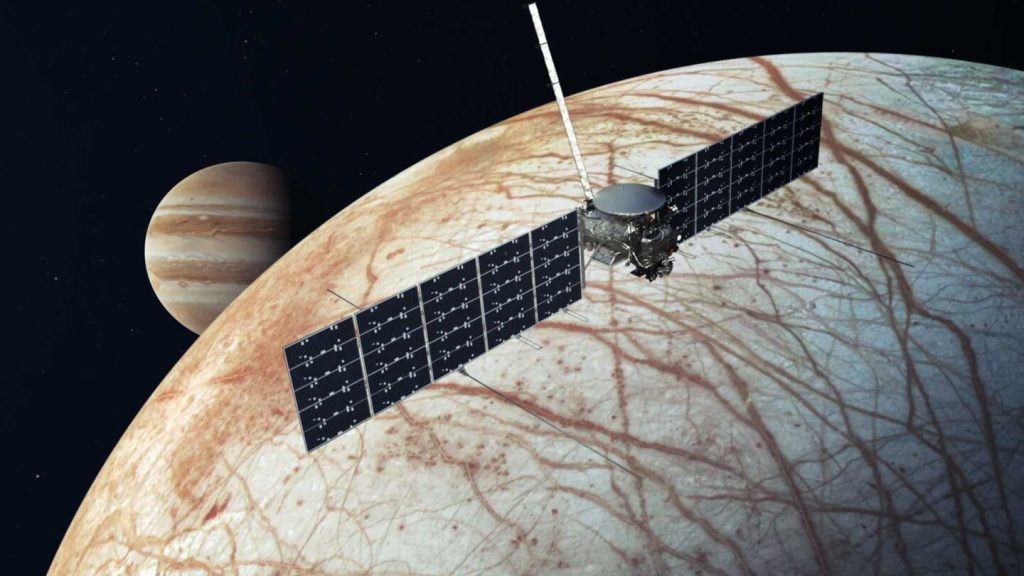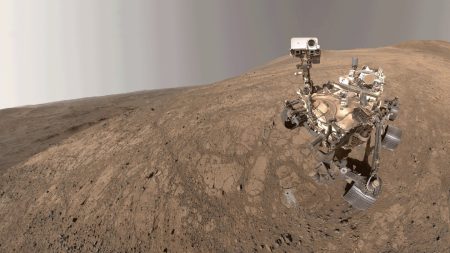NASA has launched the Europa Clipper spacecraft on a mission to explore Jupiter’s icy moon, Europa, which is considered one of the prime locations for finding extraterrestrial life. This ambitious spacecraft aims to investigate the moon’s subsurface ocean, believed to be lying beneath a thick ice crust, to determine whether its environmental conditions could support life today. By using advanced instruments, Clipper will not search for actual organisms but will assess the potential habitability of the ocean, a task highlighted by program scientist Curt Niebur as an exploration of a world that may be habitable right now, as opposed to one that was habitable in the distant past. The mission is set to take 5.5 years to reach Jupiter, making it the largest craft NASA has built for an interplanetary investigation.
Europa is one of Jupiter’s 95 known moons and is nearly the same size as Earth’s moon. Its icy shell, which measures between 10 to 15 miles (15 to 24 km) thick, conceals what is believed to be a deep ocean, possibly extending to 80 miles (120 km) or more beneath the surface. The Hubble Space Telescope has previously detected potential geysers erupting from Europa, suggesting that water may be more accessible than originally assumed. Understanding the conditions that could sustain life is crucial, as any life present in Europa’s ocean would likely be primitive, akin to the bacteria found in Earth’s deep-sea thermal vents, explained deputy project scientist Bonnie Buratti.
Once fully deployed, Europa Clipper will measure over 100 feet (30 meters) in length, about the size of a basketball court, and weigh nearly 13,000 pounds (6,000 kilograms). Its large solar panels are necessary to harness energy in the far reaches of space due to Jupiter’s considerable distance from the Sun. The spacecraft contains nine scientific instruments designed to penetrate Europa’s icy surface, map the moon, and analyze its surface and tenuous atmosphere during its flybys. The mission’s name pays homage to the swift ships that sailed the oceans centuries ago, reflecting the spirit of exploration that this project embodies.
The journey to Jupiter will be extensive, covering a distance of approximately 1.8 billion miles (3 billion kilometers). To build speed and gather momentum, Europa Clipper will perform a flyby of Mars early next year and another around Earth in late 2026. Upon reaching Jupiter in 2030, it will commence scientific observations the following year, executing 49 close flybys of Europa before concluding its mission in 2034 with a planned crash landing into Ganymede, Jupiter’s largest moon. The orbital mechanics of the mission highlight NASA’s strategic planning in maximizing gravitational assists to ensure a successful arrival and data collection phase.
Operational around Jupiter since the 1970s, several past missions have gathered significant information about its moons, including Europa. Pioneers and Voyager spacecraft captured initial images, while Galileo provided detailed flybys in the 1990s. Current missions from NASA, such as Juno, continue to expand our understanding of these celestial bodies. Upcoming is the European Space Agency’s Juice spacecraft, scheduled to reach Jupiter a year after Clipper. These various missions underline the growing interest in the Jovian system and the unique geological and possibly biological features of its moons.
Europa Clipper is not only a scientific instrument but also a vessel for messages from Earth. The spacecraft carries a triangular metal plate inscribed with the word “water” in 104 languages and features a poem dedicated to Europa by U.S. poet laureate Ada Limon. Additionally, a silicon chip containing the names of 2.6 million individuals who opted to share in the voyage serves as a symbolic gesture that connects humanity to its cosmic explorations. As scientists continue to probe the mysteries of the solar system, Europa Clipper stands at the forefront of the search for life beyond Earth, with its mission highlighting the intersection of scientific inquiry, technological advancement, and cultural expression.










